30 Americans
30 American artists share a national identity, American; however, they fracture to create their personal identity within the central themes of race and gender. These personal manifestations are shaped and molded into objects of art, which merge personal with national identity. This exceptional exhibit allows the participant to look into the eyes, souls and nightmare of these 30 Americans.
The 30 Americans exhibit is made possible through the Rubell Family. The Rubell family has been collecting publicly minded art for over 50 years. Auspiciously, the non-profit group shares their collection with other museums. 30 Americans has exhibited at: North Carolina Museum of Art; Corcoran Gallery of Art, Washington D.C.; Chrysler Museum of Art, Norfolk, VA.; Milwaukee Art Museum, Milwaukee, WI; First Center for the Visual Arts, Nashville, TN; Detroit Institute of Arts, Detroit, MI, and is currently on display in the Cincinnati Art Museum.
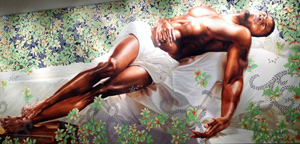
Sleep, by artist Kehinde Wiley is the first piece on display for the 30 Americans. Sleep is a prodigious piece with dynamic dimensions of 335.3 x 762 cm. The stately subject is reminiscent of the Renaissance era; however, the deep rich skin tones are not the typical foreground for a Renaissance portrait. Such deeply hued skin tones are typically reserved for the subservient subject who remains in the background. “Wiley, engages the signs and visual rhetoric of the heroic, powerful, majestic and the sublime in his representation of urban, black and brown men found throughout the world” (Kehindewiley.com).
The first floor of the Cincinnati Art Museum has a room dedicated to the 30 Americans. This display contains various mediums that juxtapose the following themes: science, economics and social-political emergence of America. First, You Became a Scientific Profile/An Anthropological Debate/ A Negroid Type/ & A Photographic Subject. This is one of the photo-graphical presentations by artist Carrie Mae Weems from her series, From Here I saw What Happened, and I Cried. Ms. Weems employs the photography of J.T. Zealy. These 1850, photographs were commissioned by Harvard’s scientist Louis Agassiz. The images were originally used to document Agassiz’s supremacist ideology, “…the human race was derived from separate biological origins” (qtd. In Cincinnati Art Museum). Ms. Weems interpreted these photos as dehumanizing; she breathed life back into the photos with etched texts of positive affirmations and infused them with blood-red tint to humanize those once labeled and manipulated specimens.
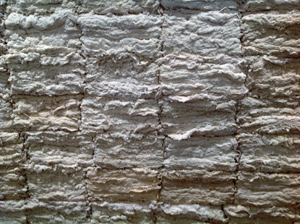
Second, Untitled #25 situates the center of the room, a cotton bale nearly as large as Wiley’s Sleep. Leonardo Drew created Untitled #25, a cotton and wax three-dimensional structure that reflects two important facets of American economics. The obvious factor that cotton was the primary product of exploitative labor; furthermore, the enormity of the art piece represents the impediment of systematic inequities of American economics. This enormous cotton bale expounds the broken backs, broken dreams, and broken spirits of the women, men and children who were enslaved and stripped of humanity while patriarchal oppressors profited.
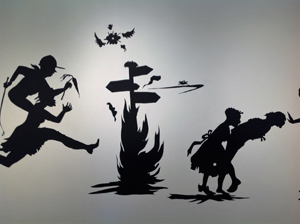
Thirdly, across from the bail of cotton, shadows cast the interplay of the social-political dynamics of America. Artist Kara Walker, a MacArthur Fellow, exposes Camptown Ladies. Upon the stark white wall, the shadows of Americas’ systemic racism, cyclical violence, and sexuality yield the search for identity. The black silhouettes demonstrate the complicated social structures that evolved during colonization. The 55 foot Victorian style silhouette comes alive if you pay attention; you can hear the children play, witness the constraints of slavery and feel the violence, sexuality and confusion as the shadows struggle to find their identity. This room intersects the science, economics, and social-political history of America.
Ascension to the third floor of the 30 Americans invites the viewer to enter through a rod iron gate with brick pillars. The entryway feels warm and inviting until you gaze upon the statuettes; the gate keepers are Ku Klux Klan hooded forms. Gary Simmons is the creator of the Klan Gate as well as Duck, Duck, Noose. This second piece expands on the entrenched racism of America. This fervent installation encompasses its own room; it has wooden stools placed within a circle; each seat contains a Ku Klux Klan hood which resembles a dunce cap. In the center of the circle a noose hangs from the ceiling. This is an example of inter-generational racism; the title alludes to a game for children yet, entwined with an adult action.
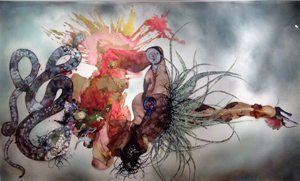

Wangechi Mutu, searches for the black female identity within mainstream media; however, the search is extraneous due to the lack of subject matter. Nonetheless, when she does find inspiration, it reflects her version of female identity. “Her women become amalgam that transcends cultural, social and racial hierarchies. So it is a collection that she striped, chopped and woven together from different sources” (qtd. In Cincinnati Art Museum). This is evident throughout her work and can be seen in her mixed media piece non je ne regretted rien. Another artist who works with fashion and fabrics is Nick Cave. While his art can be whimsical on the outside it creates a place for the identity to be muted. These pieces demonstrate beauty and lightheartedness; the identity of race, gender and other personal spaces remain autonomous and therefore, cannot be easily judged or objectified. Artist Hank Willis Thomas, a photographer makes a fashion statement regarding commodity. In his piece Branded Head, this photo speaks of the identity of black athletes and their relationship with corporations. Slave owners branded their property and traded and sold slaves as a commodity. Similarly, athletes are traded, marketed and become a commodity for the owner of the team. However, today the athletes are compensated, some very well, but at what cost to their personal identity?
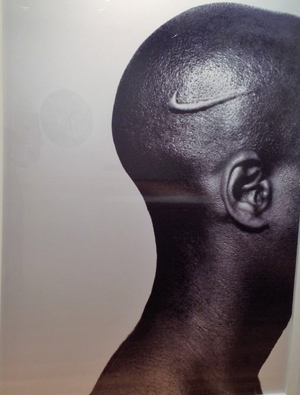
The remainder of the exhibit displays a variety of mediums; photography, paintings, collages, sculptures, and multimedia which shape the personal identity of these 30 American artists. 30 Americans exhibit is educational and visceral and for a bonus, the Cincinnati Art Museum does not charge an admission. So, if you are in the area do stop by before the show ends August 28, 2016.
Works Cited
Cave, Nick. Soundsuit. 2008. Fabric, fiberglass, mixed media. Rubell Family Collection, Florida.
Cincinnati Art Museum, Cincinnati, Ohio.
Drew, Leonardo. Untitled #25. Cotton and Wax. 1982. Rubell Family Collection, Florida.
Kehindewiley.com. Web. 30 Jun. 2016/2016.
Mutu, Wangechi. Non je ne regretted rien. 2007. Mixed media. Rubell Family Collection, Florida.
Simmons, Gary. Klan Gate. 1992. Concrete, wood, iron, mix media. Rubell Family Collection, Florida.
Simmons, Gary. Duck, Duck, Noose. 1992. Installation mix media. Rubell Family Collection, Florida.
Thomas, Hank Willis. Branded Head. 2003. Digital C- Print. Rubell Family Collection, Florida.
Walker, Kara. Camptown Ladies. 1998. Paper and adhesive on wall. Rubell Family Collection, Florida.
Wiley, Kehinde. Sleep. 2008. Oil on canvas. Rubell Family Collection, Florida.
What do you think? Leave a comment.











This may not be the show of black art we need, but it will have to do for now.
Hello Dayton, thanks for taking a spin through the article. The artists in the exhibit are sharing their identity and experiences living within the constraints of America; therefore, the work is personal and possibly not relatable to the masses. I have studied ‘the masters’ for years. I do not identify with them on most every level; however, I allow myself to understand the constraints they worked under while producing art; such as, work commissioned by wealthy patrons therefore, the work reflected that percent of the population. The one percent as we would refer to now. Then there were the constraints of producing work for entities that held power like the church. So, as the artists in the past where limited in subject, content and particular shades on their palettes I’ll return to the crux; I can appreciate their scope of work even though they are of a different gender, race and social construct than myself. Perhaps, you can get a better view of more art work if you used the links in the article or use the Instagram #cam30 for the Cincinnati Art Museum’s photos taken by patron. Thanks Venus
I very much recommend this one. It focuses on issues of racial, gender, and historical identity in contemporary culture.
Thank you Brett, for capturing the content of the exhibit. It is true the artists were examining their personal experiences with the issues of race, gender and the history and current social structures in America. I appreciate your astute overview of the intent of the article. Respectfully Venus
Powerful art!
Dearest Munjeera, thank you for your editorial review and your vibrant response. I have a #30Americans campaign on Instagram if you would like to see more of the art work. The exhibit touched so many spaces within our humanity it was grand. Peace Venus
I will check it out on my sons’ Instagrams account. I think they will be interested as well in the exhibit and your article.
Excellent article! Thank you for sharing, I can’t wait to see this exhibit! 🙂
Hi Molly, glad you liked the article. Thank you
I’m continually amazed by the self-absorption of this milieu.
I find a self-absorbed didactic milieu to be unamazing on most counts. Thanks for observation and reflection.
Thank you for this enlightening and thought-provoking article.
Krystal you are most welcome, I appreciate your comment.
Excellent analysis. Whatever minor “controversies” these artworks create in the insular and well-heeled world of middle-class art critics, they are incapable of making a lasting impression on the working masses, due to the fact that they proceed from false and corrupted ideas. No matter how much money the artists themselves have managed to make with this tripe, the art of identity politics will ultimately be swept into the dustbin of history.
Rena, thank you for your response, I really enjoyed reading it,and following your train of thought. Thank you so much for your comment.
I like the Manet.
Do the artists belong to a coherent group, is it a group that can be identified by race or skin color, and is this a liberating, restricting, or simply an ineluctable category? Thought-provoking.
Hello Glory, to answer your question no, the artists are not in a collective. The individual art work was purchased by the Rubell family and the art works are part of their collection they set up the touring exhibit.
Hope that answers you question. Thanks.
There is so much to see and learn in 30 Americans, it could easily be broken up into several smaller shows.
Hello Alta, I agree there was a lot of art to go through and yes, it could have been made into individual subsets. Thank you for your comment.
This contains a lot of great artwork
Chae, there is more to look at if you follow the links or checkout some instagrams #30americans. Hope you liked it.
I want to visit this exhibition.
There seems to be two problems that haunt this show — its premise is problematic, and it has the appearance, at least, of being a conflict of interest.
Virgen, that is a very insightful observation, thank you.
Great piece. This quite literally overflows with art from internationally renowned artists that speak to the power dynamics of race, class and political identity.
Thank you for sharing your thoughts.
Underrepresented groups aspire to counteract lack of visibility in the art world.
Cheung, I think this statement is applicable to many facets in our society, thank you.
I’ve been to this exhibition. Most of the artists in the exhibition work in figurative styles.
Lael, did you see it in Cincinnati? I purchased the book and there is a great deal more artwork available in the book than in the exhibit I saw, so I wonder if the museum has a say in which pieces are displayed. Thank you.
I’m aware that it is common speech in North America to refer to US citizens as Americans, but it is our role as cultural critics to counter imperialist practices, even if they’re only discursive. And that’s why I need to tell you that “American” is not a national identity, but a continental one.
The US imperialist discourse has normalized the employment of the American continental identity to mean exclusively US citizens, effectively silencing the rest of the thirty-four other countries who can claim American continental identity. I think magazines such as The Artifice should not condone this sort of discourse, and us, as Americans of of varied national identities, should combat it too.
Hello Ana.
The word “America” confuses me as well Ana, thank you for bringing this to the attention of our readers. I agree with you on the ambiguous mess of this word, it does alienate. However, the title of the exhibit is the 30 Americans. Additionally, the artists examine gender, racial and sociopolitical experiences; each of these factors are evident in all colonized nations. In a perfect world, the indigenous people of each American nation would be represented regarding their identity; yet, for the most part they are misappropriated. I applaud you for making your voice heard, and to keep speaking up where you see injustice.
Respectfully Venus
I was mostly referring to the inaccuracy of your first sentence, which states: “30 American artists share a national identity, American”. I wouldn’t suggest to change the name of the exhibition, just create a critical discourse around the selection and application of political definitions.
As an artist, sometimes I fear artists create, then either they or a gallery PR person concocts verbiage to inflate the pretense of the works themselves. Some of these works are clever enough, but not sure if they’re going to hold up, or appear awfully dated in a decade. Gordon Parks made some very urgent movies about the black experience in the ’60’s yet most can’t differentiate his from the other Blaxploitation flicks without a cheat sheet. And of course, his last works were rhapsodic abstract color photographs devoid of any overt political subtext. We should be suspicious of any Branding of artists of every color or persuasion, as the connotation of ownership/master/servant contaminates the message.
Mr. leftie, I like what you are saying here, this last line really resonates with me:”… Branding of artists of every color or persuasion, as the connotation of ownership/master/servant contaminates the message.”
Thank you, you are owning up to your ‘ handle’ Cheers.
Love the installations, paintings, sculptures, and videos.
Kacie thank you for mentioning the video installations they were very interesting.
Rubells are clearly attracted to art in which representations of “blackness” are visible on the surface.
Jamila, thank you for your comment, art can have so many different interpretations.
This looks like an amazing show. Unfortunately, I won’t get to Cincinnati before August 28th. Where does the show go next?
Hello, thanks for the question. The next stop is at the Tacoma Art Museum in Washington, from September 24-January 15, 2017.
Any ambitious exhibition of African-American art is long overdue.
Stellar art on view, thanks for discussing it here on The Artifice.
Thank you for supporting the arts and the publication!
Culture is a shotgun blast now and to insist on “a sense of history” only invites making one up.
A much-needed topic for viewing and reviewing! Interesting summations, but perhaps organizing the works more strictly by theme, rather than location would add to the article’s impact and clarity. Details on the exhibit’s sponsors, times, venues and dates would be better served at the end. Thank you for covering the important topic of race, especially in the visual arts!
Yes, the first piece is quite similar to a Michelangelo sculpture.